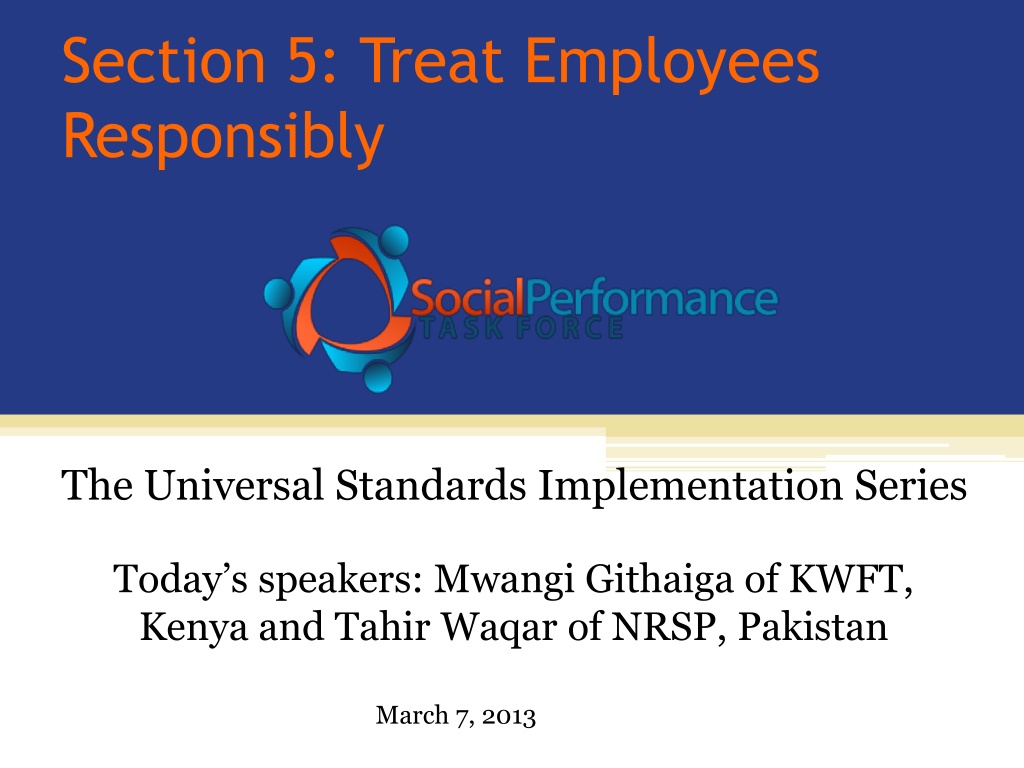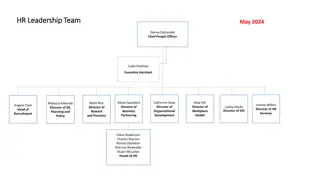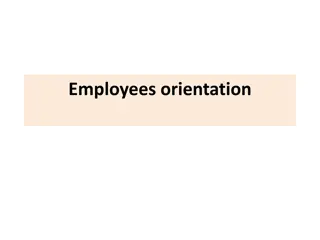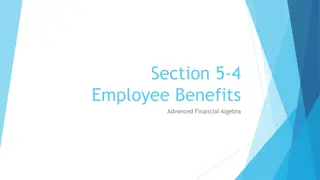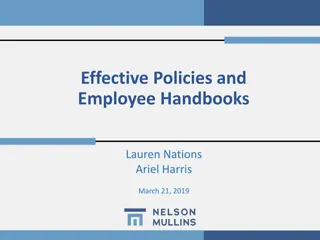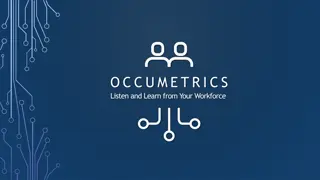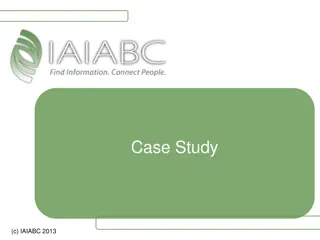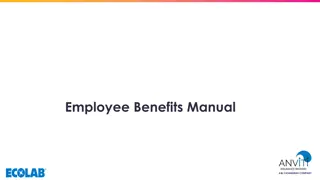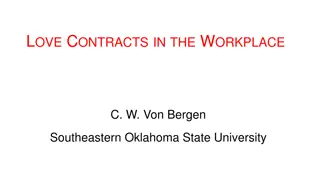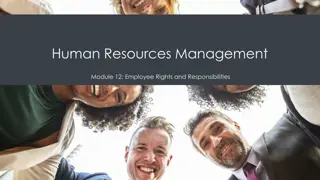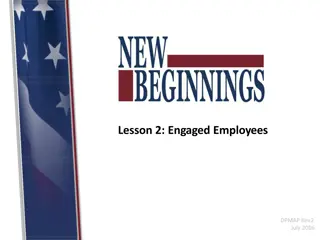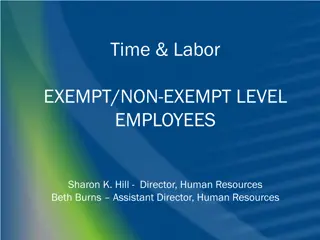Implementing Responsible Employee Treatment Policies in the Workplace
Explore Section 5 of the Universal Standards focusing on treating employees responsibly to enhance client interactions. Standards include following HR policies, communicating terms of employment, providing essential training, and monitoring satisfaction. Key practices involve ensuring a supportive work environment, fair wages, grievance mechanisms, and health & safety measures.
Uploaded on Sep 26, 2024 | 0 Views
Download Presentation

Please find below an Image/Link to download the presentation.
The content on the website is provided AS IS for your information and personal use only. It may not be sold, licensed, or shared on other websites without obtaining consent from the author. Download presentation by click this link. If you encounter any issues during the download, it is possible that the publisher has removed the file from their server.
E N D
Presentation Transcript
Section 5: Treat Employees Responsibly The Universal Standards Implementation Series Today s speakers: Mwangi Githaiga of KWFT, Kenya and Tahir Waqar of NRSP, Pakistan March 7, 2013
Agenda Review of Section 5 of the Universal Standards Interview with Mwangi Githaiga from KWFT, Kenya Interview with Tahir Waqar from NRSP, Pakistan Discussion with Participants
Section 5 of the Universal Standards Section Title: Treat Employees Responsibly Rationale: Employees have rights, and employees that are well-treated are more likely to treat clients responsibly. Three standards: 5a- The institution follows a written Human Resources policy that protects employees and creates a supportive working environment. 5b- The institution communicates to all employees the terms of their employment and provides training for essential job functions. 5c- The institution monitors employee satisfaction and turnover.
5a- The institution follows a written Human Resources policy that protects employees and creates a supportive working environment.
Standard 5a- The institution follows a written Human Resources policy that protects employees and creates a supportive working environment. Essential Practices Make HR policy available to all employees; comply with national law; and explain employees rights related to all of the following: wages, benefits, working conditions, safety at work, non-discrimination, freedom of association, and grievance resolution. Pay a living wage for employees (sufficient to provide minimally satisfactory living conditions for the employee in the location where s/he works.) Accept and respond to employee grievances through a formal and confidential grievance system that protects employees from retaliation for submitting their complaints. Assess the health and safety risks that employees face on the job and provide training and equipment necessary to mitigate those risks. Document, report, and investigate all occupational accidents, injuries or diseases.
5b- The institution communicates to all employees the terms of their employment and provides training for essential job functions.
Standard 5b- The institution communicates to all employees the terms of their employment and provides training for essential job functions. Essential Practices Provide each employee with a written job description and a written or verbal employment contract that includes his/her salary, benefits, and employment conditions. Provide each employee with job-specific training and/or skill development necessary to perform his/her essential job functions. Ensure each employee understands how his/her performance will be evaluated and rewarded by the institution. Client Protection Practice that applies: Describe: specific provisions on what is considered acceptable/ unacceptable behavior, reprimands and actions that can result in termination of employment, and penalties for non-compliance with ethics code/collections policies. Sanction violations and monitor employee practices to provide education or sanctions as necessary. (Client Protection Principle 5)
5c- The institution monitors employee satisfaction and turnover.
Standard 5c- The institution monitors employee satisfaction and turnover. Essential Practices Gather, document, and analyze employee satisfaction data. Monitor the rate of employee turnover and understand the reasons for employee exit. Take action to correct institutional problems leading to employee turnover and dissatisfaction.
Interview with Mwangi Githaiga from KWFT, Kenya Standard 5b- The institution communicates to all employees the terms of their employment and provides training for essential job functions.
Why is it important to treat employees responsibly? Are you unusual in your market? It creates satisfied employees who in turn offer better services thereby enabling the organisation to have a competitive edge. Yes. We consider each employee s individual needs and try to reach a compromise on various issues (e.g. marital, health and management development from within). Emphasis is on internal relationships to ensure external relationships with clients are well done.
How do job descriptions and employment contracts benefit your employees? Understanding of specific requirements to match job responsibilities. Contracts are signed in advance which define the rights and duties of employees and employers.
What types of training does KWFT provide to employees? Initially, we provide on the job training because microfinance operations are unique and have detailed processes. Banking. Management training and exposure to different trainings such as security, corporate governance, audit and risk management.
How does KWFT use employee evaluations? Review performance of previous year. Identify areas of strength or weakness. Identify training needs. Chart out staff career path. Plan for the next year. Determine staff salary increase.
What challenges has KWFT faced in implementing these HR policies and practices? It takes time to educate new staff on contracts, job specifications, duties and expectations. It is expensive to hold induction and orientation programs in head office and the duty stations. It is challenging to ensure standard practices across the entire institution. Turnover necessitates repetitive training for new staff and managers. The new labour laws in Kenya are not completely understood and create conflict of interests or misunderstanding.
Interview with Tahir Waqar from NRSP, Pakistan Essential Practice 2a.3- The institution accepts and responds to employee grievances through a formal and confidential grievance system that protects employees from retaliation for submitting their complaints.
How can employees complain to NRSP? Do employees feel comfortable making a complaint? Two options: Through an email address, allowing anonymous complaints Through supervisory hierarchy: contacting immediate supervisor or the higher up to the CEO level Employees feel quite comfortable because: All complaints are regularly and properly addressed. Appropriate level of confidentiality is maintained. It does not affect the complainant s career growth. Informal ways: Flexible environment, open door policy by the top management, maximum chance of interaction between employees and management.
What kinds of complaints has NRSP received from employees? Workload (over work in relation to emoluments) Harsh attitude of supervisor or colleagues Employment insecurity (fixed term project employees) Low wages or other benefits Favouratism / promotions Delays in settlement of dues (by ex-employees) Sexual harassment or discrimination (particularly by women)
Why does NRSP have a whistle-blowing policy, and do employees use it? To promote transparency, improve risk management system, and help protect reputation of the organization. Shows the commitment of the organization to integrity and ethical behavior by helping to maintain an environment where employees can act properly, without fear of revenge. It enables the employees or others to raise serious concerns (which may negatively affect the environment, working, image, programme of the organization etc) The policy applies to all employees, (including consultants, interns or probationers & volunteers) and Board Members. Regularly used by employees, mostly in staff meetings and interaction with the management. Also individuals report it through emails.
How does NRSP ensure that employees know about the grievance system and whistleblowing policy? All professional employees receive orientation training at the entry level where they are briefed about these policies. Any modification in the policy is discussed in Monthly Staff meetings along with Inter Office Memorandum (circular). All employees have access to HR manual (available in all offices). Discussed in sectoral and program review meetings.
Where to find resources SPM Resource Library for the Universal Standards: http://sptf.info/spmstandards/standards- implementation-resources This presentation and audio recording: http://sptf.info/online-trainings/universal- standards-implementation
